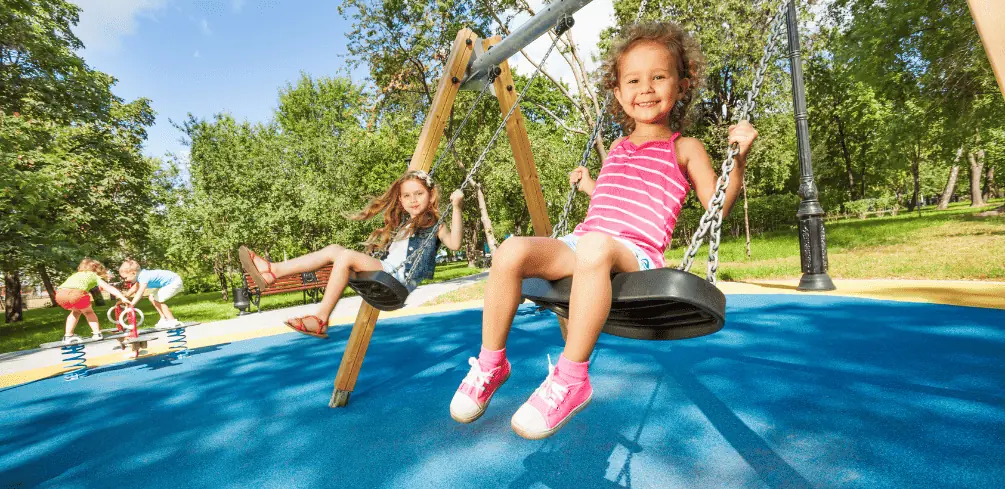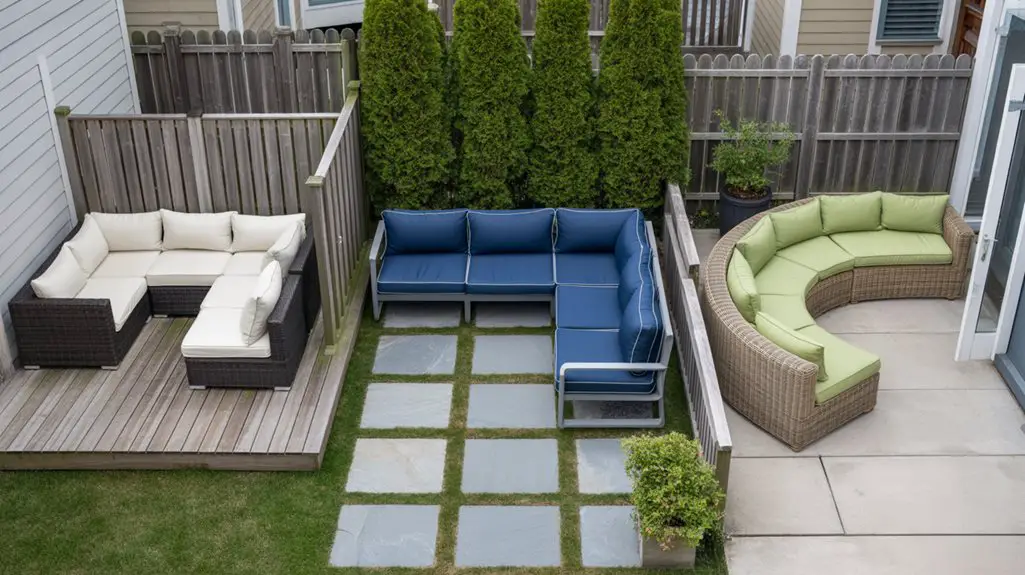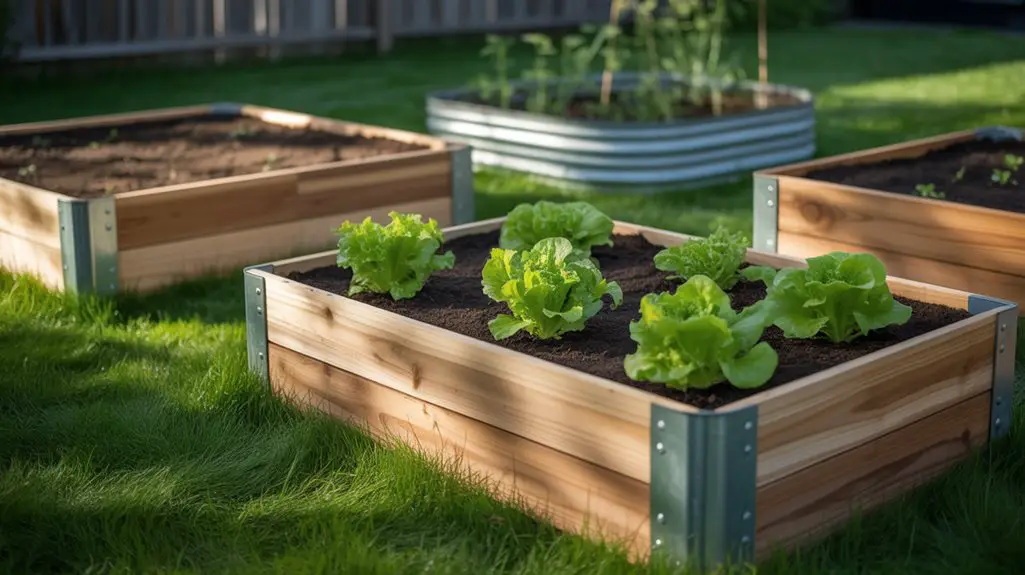As a child, there’s nothing quite as magical as the moment when you first step into your very own backyard playground.
The anticipation of endless adventures, laughter, and memories shared with friends and family seems to beckon like the sun on a warm summer day.
However, if your yard is sloped or uneven, installing that perfect playground can seem more like trying to solve an intricate puzzle than fulfilling a childhood dream.
Luckily, with some careful planning and environmentally conscious choices, you can create a safe and enjoyable play space for all.
Assessing and Preparing the Area

You might feel a bit overwhelmed when thinking about installing a playground in your sloped yard but don’t worry – with some assessment and preparation. You’ll have it ready for fun in no time!
The first thing to consider is the slope challenges that come with having an uneven terrain. Take note of the degree of the slope, as well as any obstacles, such as trees or rocks that might need to be removed or worked around.
It’s essential to ensure proper drainage to prevent water from pooling in certain areas and causing damage to your playground equipment.
Additionally, keep in mind that you may need extra support or creative landscaping techniques like retaining walls or terracing to create a stable foundation for the play area.
Next, think about area accessibility and how easy it will be for children and adults alike to get in and out of the playground zone safely.
Are there any pathways needed?
Consider adding stairs if necessary or creating gentle ramps for wheelchair access.
Make sure there are no tripping hazards along these paths, such as exposed tree roots or sharp rocks jutting up from the ground. In addition to accessibility concerns, take into account factors like shade availability during hot summer months and proximity to restrooms if possible.
Lastly, once you’ve thoroughly assessed your sloped yard’s specific needs and challenges, start planning your dream playground design!
Remember that being environmentally conscious doesn’t mean sacrificing style – get creative by repurposing materials like old tires for swings or using local plants for natural barriers between play zones.
Don’t forget practical design elements that make maintenance easier on yourself: opt for durable materials resistant to harsh weather conditions and plan ahead for long-term wear-and-tear repairs when choosing equipment pieces.
With careful consideration of all these aspects combined with your unique vision, you’ll soon have an engaging outdoor space where kids can let their imaginations run wild!
Leveling the Ground for Safety
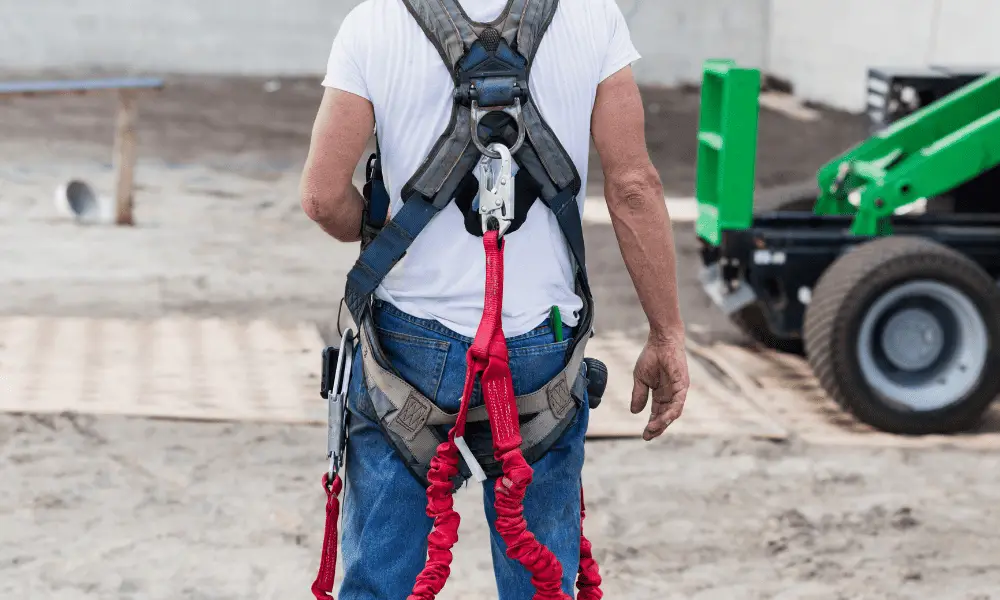
Ensuring the ground is level for a play area is crucial for children’s safety, so let’s debunk the myth that it can’t be done on uneven terrain. With careful planning and environmentally friendly techniques, you can create a safe and fun playground in a sloped yard.
Two essential components of this process are slope stabilization and ground reinforcement, which will ensure that your play area remains safe even during heavy rain or wind.
To begin with, assess the slope of your yard to determine the best method for leveling it out. For gentle slopes, you may be able to simply regrade the area by adding or removing soil as needed.
However, steeper slopes may require more advanced techniques, such as terracing or retaining walls.
Terracing involves creating flat areas at different levels along the slope to prevent erosion while allowing water to drain properly.
Retaining walls help hold back soil and provide support for these terraced sections. When choosing materials for these structures, consider using recycled or sustainable options like reclaimed wood or eco-friendly concrete blocks.
When you’ve successfully addressed any slope issues in your yard, ground reinforcement becomes paramount in ensuring the long-term safety and stability of your play area.
Utilize permeable surfaces like rubber mulch or interlocking pavers that allow water to flow through them while providing traction and cushioning for children at play.
Additionally, incorporating native plants around your playground can further aid in preventing soil erosion and promoting sustainability within your landscape design.
By taking these steps towards proper slope stabilization and ground reinforcement, not only will you create a safer environment for young ones, but also contribute positively to our planet’s well-being!
Selecting Appropriate Equipment
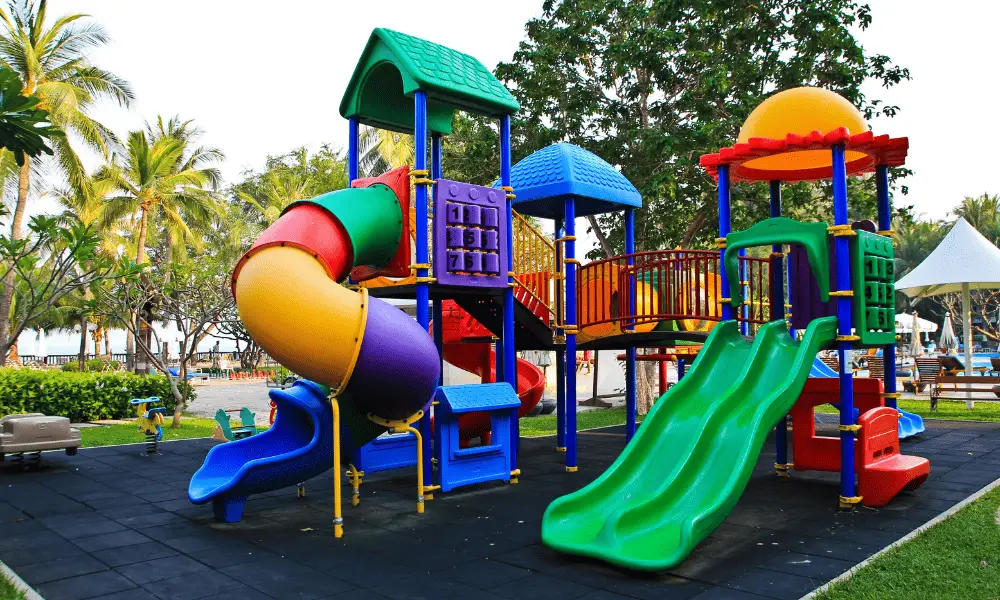
So, you’ve tackled the terrain – now it’s time to pick the perfect play equipment that’ll keep kids entertained and safe on your newly leveled ground!
When selecting play structures for a sloped yard, it’s crucial to choose slope-friendly structures that are designed with an incline in mind. This will ensure that they not only fit well within the landscape but also provide stability and safety for children as they play.
Additionally, consider environmentally friendly options made from sustainable materials like wood or recycled plastic, which contribute to a healthier planet while still offering engaging and enjoyable activities for kids.
Inclined play options are ideal for sloped yards as they capitalize on the natural gradient of your outdoor space. For example, slides built into hillsides offer a thrilling ride without requiring extensive leveling or additional support structures.
Similarly, climbing walls or rope ladders can be installed at various angles to challenge children’s physical abilities while accommodating the yard’s slope.
Other great choices include balance beams set at different heights, tiered platforms connected by bridges, and treehouses perched atop sturdy trunks – all of which make creative use of your yard’s unique topography.
As you finalize your playground design, remember to prioritize both safety and fun when choosing equipment.
Select age-appropriate components that cater to various skill levels and interests so that everyone can enjoy their time outdoors regardless of their abilities.
Look for durable materials with warranties against fading, cracking, or warping due to weather exposure – this way; you’ll know your investment will withstand years of active use.
By thoughtfully planning each aspect of your sloped backyard playground, you’re sure to create an exciting yet secure environment where children can explore their surroundings while developing important motor skills in harmony with nature.
Ensuring Proper Drainage
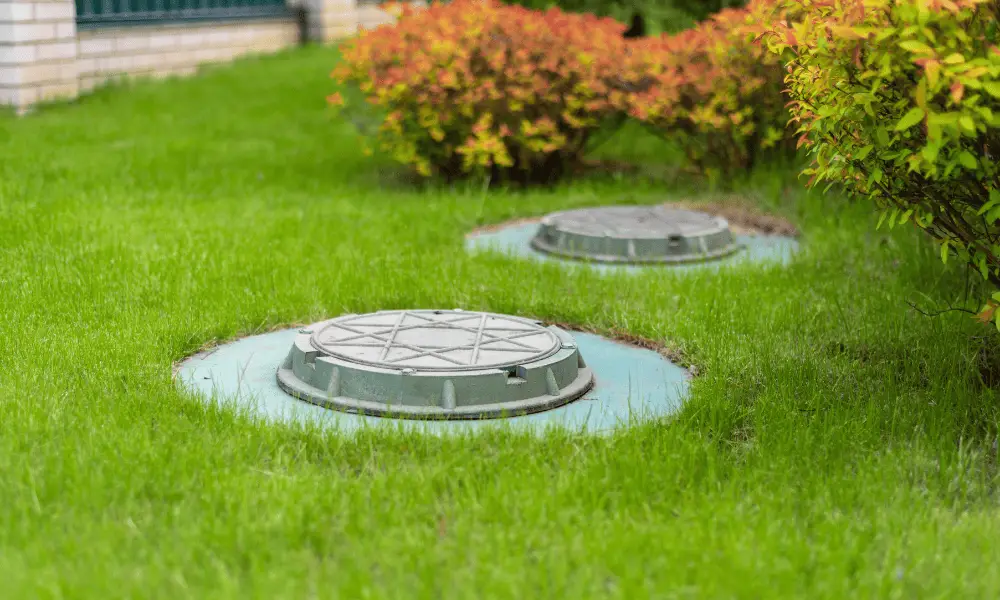
Don’t let your dreams of a whimsical play haven wash away with the rain; proper drainage is key to maintaining a safe and enjoyable outdoor space for children on an incline.
Ensuring that water runoff is effectively managed will not only prevent erosion and damage to your playground but also protect the surrounding environment.
There are various slope solutions and drainage materials available, so you can find the right combination that works best for your specific yard.
When considering different slope solutions, it’s important to take into account both the angle of the incline and soil type. Here’s a simple table outlining some common options:
| Slope Solutions | Drainage Materials |
|---|---|
| Swales | Gravel |
| French Drains | Perforated Pipes |
| Dry Creek Beds | River Rock |
| Terracing | Retaining Walls |
| Rain Gardens | Native Plant Species |
Swales are shallow ditches filled with gravel or other permeable materials that help direct water flow downhill. French drains use perforated pipes buried in trenches surrounded by gravel to carry excess water away from an area.
Dry creek beds mimic natural streambeds using river rock to slow down and disperse water runoff, while terracing creates level areas supported by retaining walls.
Rain gardens utilize native plant species adapted to wet conditions in order to absorb excess moisture.
By addressing drainage issues early on in your project, you’ll ensure that your sloped yard playground remains safe and enjoyable for years to come without causing harm to the environment.
Carefully assess your property’s unique characteristics, choose appropriate slope solutions and drainage materials, and consult with professionals if needed.
With proper planning, you’ll be able to create a magical play space that withstands both time and weather while simultaneously fostering environmental stewardship among young minds who explore its wonders daily.
Maintaining the Play Space
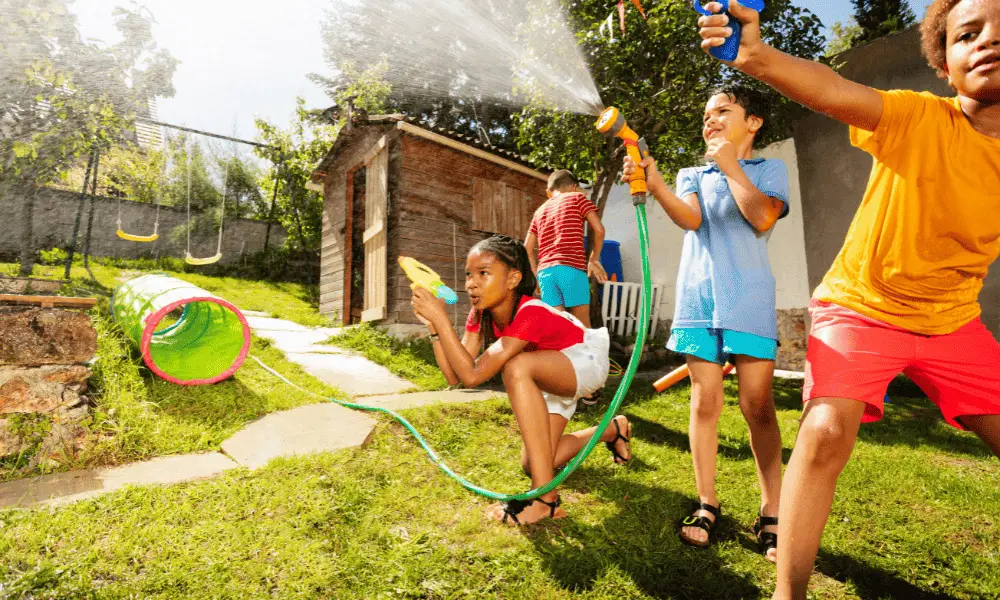
Maintaining your outdoor play area is essential for preserving its beauty and functionality, as well as promoting safety and environmental sustainability.
An important aspect of maintenance is slope stabilization, which helps prevent soil erosion and ensures the structural integrity of your play space.
To achieve this, you can incorporate ground covers like grass or mulch around the playground equipment to hold the soil in place. Additionally, consider planting native plants with deep root systems that will help bind the soil together and reduce runoff.
Surface materials also play a crucial role in maintaining a safe and eco-friendly play space in a sloped yard. Opt for materials that are slip-resistant, durable, and permeable to facilitate proper drainage while providing ample cushioning during playtime.
For instance, rubber tiles or poured-in-place rubber surfacing offer great shock absorption properties while being low-maintenance and environmentally friendly.
Alternatively, engineered wood fiber (EWF) is another sustainable choice that provides adequate fall protection while blending seamlessly with the natural surroundings.
Regular inspections of your playground equipment are necessary to ensure it remains in good working condition throughout its lifespan.
Check for any signs of wear or deterioration on slides, swings, climbing structures, and other components; repair or replace parts as needed to ensure safety for all users.
Furthermore, keep an eye on surface materials like mulch or EWF to make sure they remain evenly distributed across the playground surface—this will help maintain proper fall protection coverage while minimizing potential tripping hazards due to uneven ground levels.
By dedicating time and effort towards routine maintenance tasks like these, you’ll be able to enjoy a safe and functional sloped yard playground for years to come!
Conclusion
As the sun sets on your sloped yard, you can now watch it transform into a thriving oasis of fun, laughter, and imagination.
The seeds of joy you’ve sown will flourish in the hearts of children as they explore their new playground, all while being gently cradled by Mother Earth’s loving hands.
Remember that nurturing this lively space is an ongoing commitment. Cherish every step taken to make this dream a reality for the little ones, and let their happiness remind you that you’ve created more than just a play area – you’ve crafted an environmentally conscious sanctuary where memories are made.

